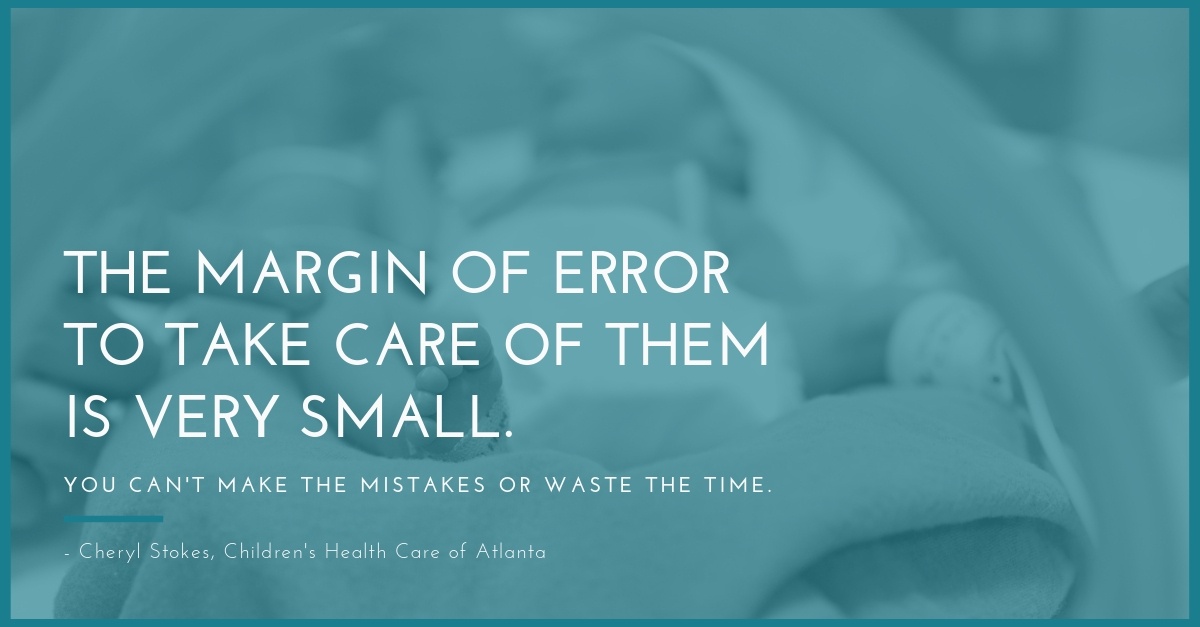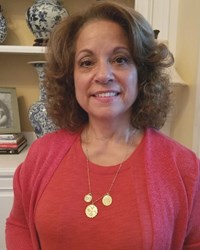Increasing Patient Access & Improving Care
Transfer Center Technology Continues to Evolve at Children’s Healthcare of Atlanta [CHOA]
Cheryl Stokes, BSN, RN, Director of Clinical Resource Management and Patient Intake at Children’s Healthcare of Atlanta, shares how finding ways manage volume at CHOA has always been a priority and that establishing a transfer center more than a decade ago has made it possible to open their doors to more patients, increasing patient access.


What you’ll learn in today’s episode:
- Everyone working in the Transfer Center has a deep clinical background. In fact, the role of patient placement is so essential to CHOA’s success, that it’s a part of the education process for all nurses.
- Processes are always evolving, and significant progress continues to be made—CHOA hasn’t had a capacity issue since 2016. Collaborating closely, nurses and doctors work very hard to move kids through the process, so they get the care they need. This level of efficiency is so important because children are more difficult to treat, and the margin of error is so small.
- CHOA has made their front-end patient intake as safe and efficient as possible and is now focusing on discharge coordination so that when patients are ready to go home they’re being discharged in a timely manner in order to open up space for new patients.
- By getting appropriate documentation to the doctors early, using the data generated by TeleTracking and information from the electronic medical record system, CHOA delivers first rate patient care—while also driving continuous improvement strategies forward.
More about this episode
About the Expert
 Cheryl Stokes, BSN, RN
Cheryl Stokes, BSN, RN
Director of Clinical Resource Management and Patient Intake at Children’s Healthcare of Atlanta
A nurse for more than 42 years, Stokes is responsible for overseeing the Transfer Center and Central Staffing Office, which involves leading a team of RNs and bed placement coordinators who facilitate almost 4,000 patient encounters per month and bed placement for three campuses. She is also responsible for a clinical informaticist, the house supervisors who help drive patient flow on the campuses, the Central Staffing Pool of over 200 RNs/PCSs and the Staffing/Scheduling Support team.
View Transcript
Host: Welcome to the Patient Flow Podcast – Powered by TeleTracking. Children’s Healthcare of Atlanta is ranked among the nation’s top pediatric hospitals in the U.S. News & World Report 2018-2019 edition of “Best Children's Hospitals.” Cheryl Stokes is the Director of Clinical Resource Management and Patient Intake at Children’s Healthcare of Atlanta.
Cheryl: Our capacity stays in the 88, 92 percent range, because we're regional tertiary center and the only real large peds program in the Southeast.
We pull patients from all of Georgia, from Alabama, the Carolinas, and Florida. We also get patients from other states that need our cardiac services or children’s cancer research center.
Host: As early as 2006, Children’s Healthcare of Atlanta was already looking at transfer center technology in order to effectively manage patient flow―and maximize the number of patients they can treat―through their three facilities. One essential part of the process? Making sure people working in the transfer center had deep clinical backgrounds.
Cheryl: We have staffed with critical care nurses from the get go. We make all of our nurses learn the bed placement process, so that they understand patients flow and what it looks like. I think that's a really important part of their orientation.
Any new employee in the transfer center, they learn bed placement. Actually managing the bed placement for the three campuses, because that's what we do. That's the bedrock of what we do, is managing those beds. Then they graduate to learning how to take physician calls. We still have manual. It's a big spreadsheet of our physician preferences. “How do our physician want patients coming in to them facilitated? Who do we call? How do we get acceptance?” We have to have a physician acceptance on every patient on the phone on the recorded line.
Host: This recorded confirmation through the transfer center brings transparency to the physician communication. Adding to their responsibilities, the transfer center has also started taking all emergency department calls, increasing volume significantly to approximately 3,500 calls per month, equating to 40,000 calls per year.
The success of Children’s Healthcare of Atlanta’s transfer center is due in large part to training. Assessing signs and symptoms, the staff in the transfer center is able to manage the calls more quickly. Working collaboratively, nurses and doctors work hard at moving kids through the process to receive the care they need.
Cheryl: Children innately are more difficult, because the margin of error to take care of them is very small. You can't make the mistakes, or waste the time. You really need to get them going. You need to recognize up front that what sort of vital signs look really bad.
Host: Of note…with an average year over year increase of 8% transfer center calls, staffing does not fluctuate. Children’s Healthcare of Atlanta staffs one bed placement coordinator per shift for the three campuses. There are also up to five nurses at any given time on a shift, depending on call volume. And, since the transfer center is open 24/7, even the nights can be busy, so the more that can be automated, the better.
Cheryl: The number of patients you get through safely per year really hits your bottom line. When we look monthly at our patient revenue streams, like everyone else does, and it's very evident when the length of stays lengthen the revenue stream slows down a bit. So Now we're trying to focus more on discharge coordination and when they're ready to go, getting them out. For peds that's a... That's a dance.
Host: Multi-disciplinary rounding plays an important role in discharge coordination. Children’s Healthcare of Atlanta is expanding this concept with the family-centered rounding, which brings the parents into the process as well. The transfer center is able to support this initiative by launching a pilot where certain types of patients end up on certain units, so that they can participate in these family-centered rounding sessions. In fact, the same doctor who admits that patient is watching that patient for their whole time that they're in the hospital.
After the pilot of the Family Center Rounding was completed, customer satisfaction went up and LOS (length of stay) decreased, allowing for increased numbers of incoming admissions. With the addition of a Bed Placement Coordinator for 5 hours during the day, they could better manage the number of calls and patient admissions that come in for the units using the new Rounding Process – adding efficiencies to the ED and getting patients to their beds faster.
This efficiencies have real life implications as Cheryl Stokes remembers from a case from when Children’s Healthcare of Atlanta was just starting their transfer center.
Cheryl: Just as we we're first starting. Middle of the night we got a call from a six hour away referring hospital, 'cause we have a lot of rural hospitals. There was some blood work that they were unsure of, they weren't happy with. So, they said that they would send the patient up to us. We said, “We'll come down and pick em up” and they refused us. It took almost ten hours for that child to show up. They were a brand new leukemic and they were in crisis by the time they came.
As soon as we got them there, we were able to get them into the ED, get them to definitive care, and the child is alive and well. It was a crisis averted, but it was because the doctors didn't recognize how sick the child really was. I can say that now when we get those calls we are much better equipped. We immediately get them on with the hem onc (hematology-oncology) doctor who says, “We will either come down and pick this child up or we will fly them”.
Host: As the Children’s Healthcare of Atlanta transfer center continues to evolve, change is on the horizon. The first priority is an entirely new space for the transfer center, allowing for greater visibility and also recognizing the opportunities for growth. As the reputation for the service Children’s Healthcare of Atlanta provides has grown throughout the network, including the fact that all of our urgent care centers now have a direct line, it has also made expansion necessary.
Cheryl: We're really pretty excited with the growth that our system has allowed us to have and the tools we use make a huge difference. If we can get appropriate documentation to the doctors at an early time, we’re looking forward to automating that piece of it hoping that what we can do is, actually build some kind of an interface where we can pull that record that we're writing directly into their medical record. I think that is a place that we're headed towards.
Host: This is the Patient Flow Podcast -- Powered by TeleTracking. Your source for insightful conversations with industry leaders making a difference in patient flow today.
We're glad you're enjoying our resources! Please tell us more about you to access our full library.
This will allow us to personalize your experience on TeleTracking.com. Of course, we will never sell your information and you can opt-out at any time. Need help now? Contact a Patient Flow expert.
Leaving the website
You're about to leave this website, to one of our affiliates or another information source.